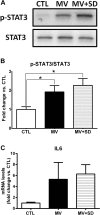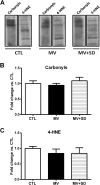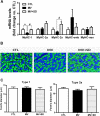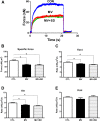Mechanical ventilation causes diaphragm dysfunction in newborn lambs
- PMID: 30992039
- PMCID: PMC6469194
- DOI: 10.1186/s13054-019-2409-6
Mechanical ventilation causes diaphragm dysfunction in newborn lambs
Abstract
Background: Diaphragm weakness occurs rapidly in adult animals treated with mechanical ventilation (MV), but the effects of MV on the neonatal diaphragm have not been determined. Furthermore, it is unknown whether co-existent lung disease exacerbates ventilator-induced diaphragmatic dysfunction (VIDD). We investigated the impact of MV (mean duration = 7.65 h), either with or without co-existent respiratory failure caused by surfactant deficiency, on the development of VIDD in newborn lambs.
Methods: Newborn lambs (1-4 days) were assigned to control (CTL, non-ventilated), mechanically ventilated (MV), and MV + experimentally induced surfactant deficiency (MV+SD) groups. Immunoblotting and quantitative PCR assessed inflammatory signaling, the ubiquitin-proteasome system, autophagy, and oxidative stress. Immunostaining for myosin heavy chain (MyHC) isoforms and quantitative morphometry evaluated diaphragm atrophy. Contractile function of the diaphragm was determined in isolated myofibrils ex vivo.
Results: Equal decreases (25-30%) in myofibrillar force generation were found in MV and MV+SD diaphragms compared to CTL. In comparison to CTL, both MV and MV+SD diaphragms also demonstrated increased STAT3 transcription factor phosphorylation. Ubiquitin-proteasome system (Atrogin1 and MuRF1) transcripts and autophagy indices (Gabarapl1 transcripts and the ratio of LC3B-II/LC3B-I protein) were greater in MV+SD relative to MV alone, but fiber type atrophy was not observed in any group. Protein carbonylation and 4-hydroxynonenal levels (indices of oxidative stress) also did not differ among groups.
Conclusions: In newborn lambs undergoing controlled MV, there is a rapid onset of diaphragm dysfunction consistent with VIDD. Superimposed lung injury caused by surfactant deficiency did not influence the severity of early diaphragm weakness.
Keywords: Lung injury; Mechanical ventilation; Neonatal; Surfactant deficiency; Ventilator-induced diaphragmatic dysfunction (VIDD).
Conflict of interest statement
Ethics approval and consent to participate
The study was approved by the animal research ethics board of the University of Sherbrooke (protocol # 423-17B) and performed in accordance with the Canadian Council on Animal Care.
Consent for publication
Not applicable.
Competing interests
The authors declare that they have no competing interests.
Publisher’s Note
Springer Nature remains neutral with regard to jurisdictional claims in published maps and institutional affiliations.
Figures





Similar articles
-
Relationship between Autophagy and Ventilator-induced Diaphragmatic Dysfunction.Anesthesiology. 2015 Jun;122(6):1349-61. doi: 10.1097/ALN.0000000000000656. Anesthesiology. 2015. PMID: 25828754
-
Angiotensin 1-7 protects against ventilator-induced diaphragm dysfunction.Clin Transl Sci. 2021 Jul;14(4):1512-1523. doi: 10.1111/cts.13015. Epub 2021 May 1. Clin Transl Sci. 2021. PMID: 33742769 Free PMC article.
-
Ventilator-induced diaphragm dysfunction: cause and effect.Am J Physiol Regul Integr Comp Physiol. 2013 Sep;305(5):R464-77. doi: 10.1152/ajpregu.00231.2013. Epub 2013 Jul 10. Am J Physiol Regul Integr Comp Physiol. 2013. PMID: 23842681 Review.
-
Hydrogen sulfide donor protects against mechanical ventilation-induced atrophy and contractile dysfunction in the rat diaphragm.Clin Transl Sci. 2021 Nov;14(6):2139-2145. doi: 10.1111/cts.13081. Epub 2021 Jun 16. Clin Transl Sci. 2021. PMID: 34080307 Free PMC article.
-
Ventilator-induced diaphragm dysfunction: phenomenology and mechanism(s) of pathogenesis.J Physiol. 2024 Oct;602(19):4729-4752. doi: 10.1113/JP283860. Epub 2024 Aug 31. J Physiol. 2024. PMID: 39216087 Review.
Cited by
-
Identification of the co-differentially expressed hub genes involved in the endogenous protective mechanism against ventilator-induced diaphragm dysfunction.Skelet Muscle. 2022 Sep 9;12(1):21. doi: 10.1186/s13395-022-00304-w. Skelet Muscle. 2022. PMID: 36085166 Free PMC article.
-
Aldh1a1 and Scl25a30 in diaphragmatic dysfunction.Exp Biol Med (Maywood). 2022 Jun;247(12):1013-1029. doi: 10.1177/15353702221085201. Epub 2022 Apr 11. Exp Biol Med (Maywood). 2022. PMID: 35410502 Free PMC article.
-
Endoplasmic Reticulum Stress Contributes to Ventilator-Induced Diaphragm Atrophy and Weakness in Rats.Front Physiol. 2022 Jun 27;13:897559. doi: 10.3389/fphys.2022.897559. eCollection 2022. Front Physiol. 2022. PMID: 35832486 Free PMC article.
-
Rbm20ΔRRM Mice, Expressing a Titin Isoform with Lower Stiffness, Are Protected from Mechanical Ventilation-Induced Diaphragm Weakness.Int J Mol Sci. 2022 Dec 10;23(24):15689. doi: 10.3390/ijms232415689. Int J Mol Sci. 2022. PMID: 36555335 Free PMC article.
-
Evolution of inspiratory muscle function in children during mechanical ventilation.Crit Care. 2021 Jun 30;25(1):229. doi: 10.1186/s13054-021-03647-w. Crit Care. 2021. PMID: 34193216 Free PMC article.
References
MeSH terms
LinkOut - more resources
Full Text Sources
Miscellaneous

